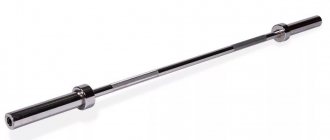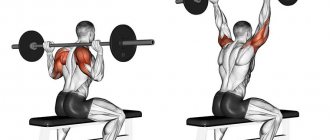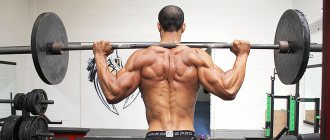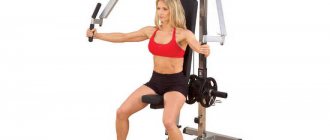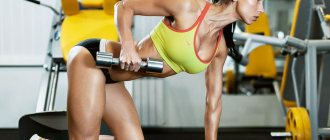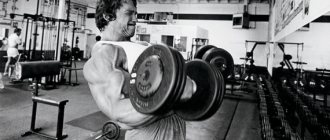Content
- 1 What are free weights
- 2 Benefits of working with free weights
- 3 Features of training with free weights
- 4 Tips for using free weights
Video: free weights or exercise machine?
Free weights in bodybuilding and fitness refer to barbells, kettlebells and dumbbells. Some individuals also train with weights. Strength sports also use weighted ropes, sleds, sandbags, weighted balls, kegs, lifting stones, and fat barbells. In health fitness, there are various weighted vests and ankle and wrist weights.
Attention: free weights area!
Photo: Construction and operation of sports facilities
Neither a large fitness center, nor a small club, nor a simple “rocking chair” can do without a free weights area. Whatever the format of the gym, it is important to pay sufficient attention to equipping this area.
Exercises with free weights are always popular among club clients. They are more natural than training on machines, that is, their value for everyday life and various sports is much higher than when working on machines. Not many of them can reproduce the complex of loads during exercises that involve several muscles and joints at once. Also, not all exercise machines can provide the same trajectory and range of motion that the working muscle receives when training with free weights. Only simulators with clearly proven biomechanics are capable of this, and these are quite expensive models. Free weights that perform the same function will cost much less.
Modern manufacturers of sports equipment offer a wide range of accessories for this area. Let's try to figure out what free weights are, what purposes they are intended for, and what you should pay attention to when choosing them.
Design of the free weights area
It is usually located near the strength training area, and sometimes combined with it. The free weights area should be equipped based on the general concept of the club. There must be mirrors in the hall. The gaze of a person exercising with free weights should not rest on the wall; he should see his reflection in the mirror, because this allows the client to control the “technique of execution” of the exercises. When choosing a mirror, it is better to avoid frames with ornaments. It is enough to hang several mirror canvases close to each other (or order a solid canvas from the workshop) on each of the walls, with the exception of those with windows or doors.
The floors must be covered with a special floor covering with great wear resistance, which will prevent the foot from slipping when working with weights and reduce the load on the joints due to shock absorption.
It is also worth paying attention to the lighting and ventilation system, which are important when conducting classes.
Types of free weights
Free weights are barbells, dumbbells, kettlebells, handles, etc. Conventionally, they can be divided into 6 main types:
- Dumbbells differ not only in weight, but also in purpose: fixed dumbbells for strength training, chrome-plated dumbbells for fitness training, dumbbells for aerobics in a vinyl or neoprene shell. There are also non-standard types of dumbbells. Such as, for example, typesetting. The cassette weight gain mechanism allows you to change weight in 2-3 seconds. Such dumbbells can be used in small gyms, because... With 1 set of such dumbbells (including all weights), only 1 person can exercise at a time.
- The barbell is either a separate bar with discs attached to it, or a solid fixed bar with discs. Fixed bars allow you to avoid wasting time searching for discs of a certain weight - there is no need to repeatedly assemble and disassemble the bar.
- Bars can vary in length, weight, base diameter, sleeve diameter and purpose. Accordingly, they can be training, Olympic, or pump aerobics bars in terms of size and purpose. This section also includes bar locks that secure discs. Locks are also divided into several types, the most commonly used of which are the spring lock and the compression ring.
- Modern manufacturers offer a wide range of discs. The most common of them - Olympic discs with a 50mm mounting hole - fit most bars. Colored rubber or urethane discs will not only enliven the interior of the club, but will also help clients choose the required disc by weight based on its appearance, because... a color distribution system according to weights is standard for all manufacturers.
- Kettlebells, like other free weights, vary in size, weight and purpose. Exercises with sports weights are gaining more and more popularity. They allow you to perform many strength exercises of a wide variety of nature, which explains their popularity.
- The handles are not used as independent free weights; they are an integral part of the exercise equipment. Rotating straight and curved bars, deadlift bars, power handles - all these accessories are used when working with block and multi-block exercise machines.
Number of free weights
Of course, the set of equipment for the free weights area will vary depending on the size of the hall and the format of the club, but there are certain rules when selecting free weights.
In a standard gym, the dumbbell row will be represented by a wide range of weights - from 1 kg to 60 in 1-2 kg increments, so that clients can increase the load with each workout. It is necessary to provide several sets of dumbbells of different weights, especially for light dumbbells for aerobics, because they are used for group classes, as well as 1-2 sets of especially large weights.
The number of fixed rods is selected depending on the specifics of the club. But it’s good to have at least one set of fixed barbells of various weights, provided that there are also bars and weight disks. The number of bars must at least correspond to the number of exercise machines, benches and power racks on which they are used. The number of sets of weight plates should match the number of bars, racks and free weight machines, so that when all machines are occupied, clients do not have to wait for each other to change weights.
There are also some features to consider when choosing free weights. For example, rubber and urethane discs, dumbbells and barbells do not create noise or leave scratches on equipment or paintwork. On the other hand, rubber dumbbells, unlike urethane dumbbells, can leave streaks on smooth floors.
Optional equipment
To work with free weights, in addition to the dumbbells, barbells and disks themselves, additional equipment will be required. It can be divided into two groups:
- benches and frames for performing exercises with dumbbells and barbells;
- exercise machines loaded with weight disks.
When selecting equipment for strength training, it is necessary to take into account the specifics of the gym or club. A men's gym will require more hardware (dumbbells, barbells, weights), more machines for working with free weights (including benches for bench presses at different angles). In the women's gym, you can get by with a minimum of exercise equipment with free weights and lighter dumbbells.
When choosing exercise machines and benches for working with free weights, you should pay attention to the reliability of the design, the maximum weight that the racks for the barbell and disks can withstand, the width between the racks, the ability to adjust the height of the racks, the angle of the bench, and the presence of additional adjustments.
Storage systems
Free weight storage requires a variety of racks to support the equipment when not in use. Often, manufacturers of free weight machines, to save gym space and ease of use, place pins for storing discs directly on the machine or power frame.
When ordering stands and racks, it is important to pay attention to the compliance of the storage systems with the free weights themselves that are planned to be placed on them, because For each type of free weights, there are different types of racks. So, aerobics dumbbells cannot be placed on a chrome dumbbell rack. And the stand for pump aerobics will not fit Olympic discs and long barbells. The opposite situation is that it will also not be possible to place discs for pump aerobics on a standard rack for Olympic discs, because The diameter of the seat ring for these discs is much smaller.
At the stage of ordering equipment, it is necessary to study all the additional services that suppliers of free weights can provide when equipping the hall. Some free weight manufacturers offer fitness clubs and gyms personalized dumbbells, barbells, kettlebells and plates by placing the club logo on the free weights. This innovative solution allows you to give your fitness club an additional competitive advantage. Personalized free weights and exercise equipment enhance the club's status in the eyes of the client.
Benefits of working with free weights
A significant advantage of working with free weights is versatility. With dumbbells and a barbell, you can not only work out all the muscles of the body, but also train for endurance and increase the efficiency of the cardiovascular system. Such equipment can give us mass, strength, “relief”, and help in “burning” calories. A minimum set of weights is enough to build a home gym, and perform more than 30 different exercises for all muscle groups.
Proper technique for working with free weights is the key to preventing household injuries. It allows you to eliminate various “distortions” during lifting weights from the floor, gain the skill of squatting with a neutral back, improve the range of motion in the shoulder joints, and thereby avoid injury when lifting weights upward.
Working with free weights actively engages almost all the muscles of the body. With such weights we do basic exercises. They involve not only target groups, but also stabilizer muscles. The result is not only harmonious development, but a greater training effect. With simple equipment, we expend more energy during training and load more muscle groups per unit of time.
Training with free weights is an important skill that allows you to train in almost any gym, while traveling, traveling, and even at home. This helps to avoid being tied to a particular gym and make training more regular.
Zones in the gym
In any rocking chair you can see a conditional division of the entire space into 2 parts:
- cardio zone;
- power zone.
The cardio zone includes treadmills, ellipses, exercise bikes, steppers, and stairs. In it you can usually see girls, girls, women who come to the gym only for cardio training, so during peak hours there is often no free space left here.
The population of the power zone is predominantly men. In it you can see barbells, dumbbells, weights, plates, block devices, and strength training equipment. And also strange sounds during heavy exercises, the smell of sweat, phrases “yourself, yourself,” “let’s do it 3 more times!” and others. Mainly inhabited here are:
- jocks who are not averse to self-admiration in the mirror and checking their biceps after each approach;
- newcomers who are trying their best to become like the first option.
But you can also meet girls here who came for a sculpted body.
Features of training with free weights
The main feature is the need for complete mental concentration and knowledge of the basics of movement. During the lesson, distractions and extraneous thoughts are not allowed; the athlete must consciously monitor the trajectory of the projectile. This is quite difficult considering the fatigue and sensations in the muscles. That’s why free weights are not always used in health fitness right away.
Movement training required. The technique of working with free weights must be established; most people do not “grasp” it themselves from the first lessons, and get injured, accumulating technical errors over time
It is quite difficult to work with free weights when recovering from injuries, at an older age, during pregnancy, and also during rehabilitation after illness. This must be taken into account and either reduce the weight of the weights or revise the training plan.
Benefits of simulators
Of course, free weights have a number of advantages and positive characteristics, but you should not neglect exercise machines, because they can also be useful. The following positive functions of the simulators are noted:
- Activation of one muscle group. When comparing exercise machines with barbells and dumbbells, dumbbells managed to win, but the exercise machines also have good performance and can activate a certain muscle group;
- Providing constant resistance. Many machines are capable of providing a uniform resistance curve. Even in cases where free weights cannot cope with this task. For example, when performing a bench press, there is not much tension at the top or bottom of the range of motion. Almost everyone has a convergence point in the middle when their performance sags. The original curve and its top are in the correct position, but the middle falls out of this load graph;
- Isolation of a specific muscle . If the main goal of the training is to develop existing weak points, then the simulator is the best option. For beginners, this function, in most cases, is useless, because they need to focus on the overall development of the body, but experienced athletes successfully use exercise machines to develop a selected muscle group;
- Greater level of security. It is impossible to clearly compare the safety level of free weights and exercise machines. But there is an opinion that it is free weights that wear out the human body and have a destructive effect on it. This assumption is based on the fact that barbells and dumbbells cause greater tension in the muscles and, as a result, provoke the development of injuries, both acute and chronic. For example, squats negatively affect the knees, deadlifts negatively affect the lower back, and bench press negatively affects the shoulders. Of course, exercise machines also provoke a number of injuries and negative consequences, but more and more professional athletes over time give preference to the exercise machine due to the lower level of injury risk;
- Ability to quickly change weight. It is easy to change the load level on exercise machines by simply changing the program. To do this, you don’t need to stop training for a long time and rebuild. But on a barbell, the process of changing weight and fixing it takes longer. The same applies to dumbbells; preliminary preparation is required if you plan to change the weight used during the workout itself.
Tips for using free weights
You need to start working with free weights by studying the technique of the exercise and performing the movement with minimal weight. You should progress gradually; until you have mastered the skill of concentrating on an exercise, you cannot progress. Additionally, you must always ensure that there is no excessive arching in the lower back, that the stomach is not relaxed, and that the implements do not move by inertia.
Training with free weights can and should be combined with work in machines, especially when it comes to muscle hypertrophy. It is easier to gain training volume by combining both types of equipment.
